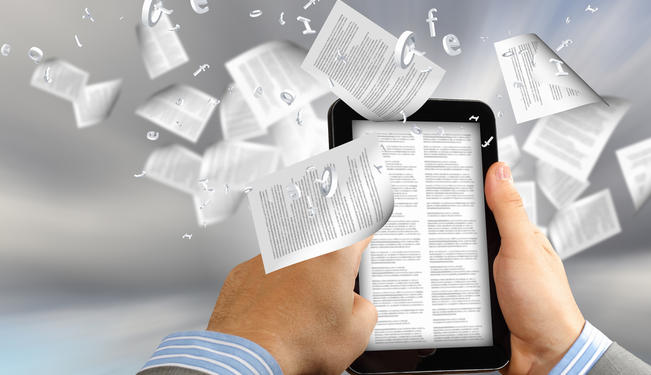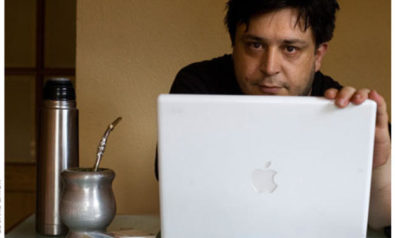Julián Chappa talks to José Manuel Lucía Megías about the present and future of digital publishing.
Julián Chappa: How did your first experience with an e-book take place?
José Megías: I began to get interested in e-books during the sharing of online texts in 1997. That same year, I was dealing with all the necessary paperwork to create a virtual library, which did not end up launching because the University of Alicante’s Miguel Cervantes’ Virtual Library emerged two years later, in 1999. In 1998, I wrote my first book on the subject, Online editing (che quanto piace il mondo e breve sogno), which was published in Incipit, a very prestigious Argentinian magazine, edited by Germán Orduna. I was — and still am — interested in the subject, hence I have always tried to attract the e-reader. I do most of my reading on my iPad and use the device to listen to music, watch videos and films, store photographs, surf the net, and play games.
Chappa: Are we really assisting in the creation of something much more transcendent than the invention of printing?
Megías: Printing, as a form of technology, solved a business necessity, which medieval scripturers could not: the mass production to meet the increasing demand in Europe in the 14th century. Johannes Gutenberg’s printing press (and his great invention of using moveable devices, the key to his success) aspired to speed up production. Gutenberg’s first succesful book was the Bible. Each writing format is going to establish a number of changes with regards to the text’s configuration and layout, and each era will create different literary models with a unique set of language and style characteristics, which will facilitate their classification into different genres and movements.
Online publishing requires a set of changes to the text’s syntax and its simplicity — there is an increase in segmentation to facilitate the inclusion of links and the need to link different information. All of this represents a substantial change with regards to what we have known until recent times. Since the invention of writing and its consolidation as a form of knowledge in 4th century Greece, writing technology was based in a physical element that separated it from some of the characteristic oral elements. On first impression, digital text utilizes the same traditional writing values (symbols and cognitive model). But if one digs deeper, it becomes apparent that it is based on a mathematical language which stores much more information than appears on the computer screen or tablet. This clearly means that we still need to explore the possibilities offered by digital text. We have done a lot but there is still much more to do.
Chappa: In your book, you refer to digital text as a propulsor of a “new orality” and “a new textuality.” Could you please clarify both concepts?
Megías: Until writing became established as a medium of basic education, the traditional method used to share knowledge was through oral interaction. Plato learned from his master, Socrates, through the use of dialogue, but Aristotle preferred to stay at home learning about dialogue from written text rather than attending lectures at the academy. Orality has not been marginalized in our society. We had a strong oral tradition in the Middle Ages — an orality that has been restricted to private spheres in low-literacy cultures. The invention of audiovisual devices in the 19th and 20th centuries have given way to a “second orality,” based on the oral transmission of knowledge which is supported by the propagation of a written text, in the form of TV, cinema or radio scripts.
I have based my premise on this in order to coin the term, “second textuality,” to aid me with my description of the “digital text.” It is “textuality” because it is based on writing (alphabetical signs that we learn to read, recognize, and create), but it is not done in a physical medium. Instead, this occurs in a virtual space, thus enabling us to rediscover a few traditional elements that we had lost: the possibility to create groups, the ability to read and write regardless of the writer and receptor’s location. The digital text, “the second textuality,” becomes a new way of syncretism in the orality and scripture paradigm, considered as two independent sources of the generation and transmission of ideas and knowledge.
Chappa: Can you please tell us a little bit more about what projects you are currently working on?
Megías: I am currently working on various different digital humanities projects. I am working to expand Quijote’s 1605-1915 image library, which is the best of its kind available online. The aim is to try and develop a Quijote hyperedition, which is due to be released in 2015, to celebrate the 400 year anniversary of the release of part II. I am also involved in the virtual restoration and digital edition of the “Tristan de Leonís” in Spanish — there are only 60 fragments available in Spain’s National Library. I am also working on a Digital Hispanics Humanities Manual.
Chappa: The 2007 launch of ePub’s standard format did not achieve the predicted results for the emergence of e-books. When do you think e-books will achieve mass-acceptance and what tool do you deem necessary to achieve this?
Megías: The ePub is the standard format for electronic texts, created by the International Digital Publishing Forum (IDPF). The ePub highlights the content of digital texts as opposed to their format, which means that it can be read across a broad range of different devices. The biggest innovation is the fact that the text transcends a closed space, which can be tagged (such as TEI) and becomes a compatible, open space. Hence why it is seen as a standard format to code and distribute digital texts, regardless of the brand or device that the user has access to.
The ePub was trying to solve an issue before this had emerged: the need for standardization. What is the alphabet? A standard. What is the ASCII code? A standard. The ePub went beyond creating a scripture that would be recognized by any device, it wanted to take advantage of the web’s characteristics, the new way in which we are getting used to receiving and obtaining information.
We have two problems. On the one hand, there is the industry’s struggle to conform to standardization and its constant desire for the user to move between different languages, which are incompatible among themselves, in order to maximize their financial gains on technological development. Then, there is the issue of creating a standard textual model. We need to go beyond perceiving digital texts as the identical counterpart to analogical texts, only discerning between their medium. Why move away from print if I can get everything that I need from a book? I agree with those who think this way, just like I would agree with those who loved unique manuscripts and were very much opposed to the emergence of editorial mass production in the 15th century.
Chappa: Why have many big Ibero-American publishing houses made a decision to stay away from e-books? Is this due to dissidence, arrogance, or ignorance?
Megías: I don’t think that there is an issue with either dissidence, arrogance, or ignorance. Perhaps there is an issue with all three. We have suffered from a widespread tendency to reject the incoming changes to the traditional publishing business, which undoubtedly come from the industrial editorial model that succeeded in the 19th century. The big publishing houses, with all their economic power and media coverage, thought that they could control this danger in the same way that some of the greatest IT companies arrogantly rejected the laptop in the 1970s and have since then been forced to accept it.
Big publishing houses struggle with changing their business model, which is primarily based on stocking millions of book copies and their distribution, a notion based on mass-producing books. A lot has changed in the last few years, and much more is due to change when we can achieve universal wi-fi and internet access. Right now is the perfect time for creative publishing houses to flourish and innovate. Yesterday’s business models are no longer applicable to today, and will definitely be outdated by tomorrow. I think that it will take a while, but those publishing houses that do not embrace a much more digital outlook are sentenced to fail.
Chappa: Perhaps the publishing industry needs to be pushed out of its comfort zone, just as the music industry had been in the previous decade, in order to grasp that it is about to hit a dead-end.
Megías: I think that this is already happening. It is true that the e-book and digital text market is stagnant and has not completely launched (due to a lack of titles, editors and restricted Internet access, etc). But it is also true that hard-copy sales have suffered a considerable decrease. The only thing that is increasing rapidly is piracy, which has become an underestimated niche. The old system is sentenced to disappear because it suffers from the same ailments as dinosaurs did. The one thing that we have learnt from the changes that have taken place in the music industry is that we are no longer dealing with a passive consumer. The consumer is now receptible to new habits and trends — so much so, that the industry is now shaped by the reader’s use.
Chappa: It has been claimed that we only use 10% of our brain. It seems that this is also happening with the enormous potential of e-books, which in this age continues to be overlooked, especially in the Spanish and South American markets. Is there a private or public project to tackle this?
Megías: I am not aware of any. Unfortunately, in America, like in Europe, we have spent millions in an attempt to digitalize our heritage and our written memory in order to try and offer an alternative to Google Books. This financial investment has not been accompanied with an investment in technological advancement, which is necessary for the creation, diffusion, and conservation of knowledge in the digital sector. The big library projects that took place in the 1990s have been replaced with big, general libraries, which offer thousands and millions of digital documents, but fail to go beyond the pre-established analogue models.
Chappa: The digital book seems to have caused a mere quantitative change — when the challenge lies in qualitative changes — to enrich the multimedia experience offered by the new support systems that are currently available. What do you envision happening?
Megías: The great thing about digital technology is that it does not follow a specific route, it is shaped by the user’s behavior, by its habits, and by the lack of alternatives. At the beginning of the 21st century, we would only talk about a semantic web, its ability to pass on information to our cognitive elements, and we believed that this was the key to the future and that it was going to change the way in which we forge relationships.
Then, all of a sudden, a couple of youngsters realized that the available technology, at the time, did not provide answers to their problems and so they began to come up with systems that enabled users to create content. This is true when we talk about personal webpages, blogs, photo albums, Flickr, personal video collections, YouTube, chats, messages, Facebook, Twitter, etc. The Web 2.0 has changed and continues to shape the way in which we access and create content.
What does the future hold? I have no idea. The one thing that I am sure about is that it solely depends on what we want it to be. If we continue to look the other way, or complain about better times, we are sentencing ourselves to a lack of progress. Alternatively, we will allow others to progress and we will then suffer the consequences when it comes to adaptation. We will never be more than visitors of the future, second class citizens to the true innovators.
*[This article was translated from Spanish to English by Yessi Bello Perez.]
The views expressed in this article are the author's own and do not necessarily reflect Fair Observer’s editorial policy.
Image: Copyright © Shutterstock. All Rights Reserved.
Support Fair Observer
We rely on your support for our independence, diversity and quality.
For more than 10 years, Fair Observer has been free, fair and independent. No billionaire owns us, no advertisers control us. We are a reader-supported nonprofit. Unlike many other publications, we keep our content free for readers regardless of where they live or whether they can afford to pay. We have no paywalls and no ads.
In the post-truth era of fake news, echo chambers and filter bubbles, we publish a plurality of perspectives from around the world. Anyone can publish with us, but everyone goes through a rigorous editorial process. So, you get fact-checked, well-reasoned content instead of noise.
We publish 2,500+ voices from 90+ countries. We also conduct education and training programs
on subjects ranging from digital media and journalism to writing and critical thinking. This
doesn’t come cheap. Servers, editors, trainers and web developers cost
money.
Please consider supporting us on a regular basis as a recurring donor or a
sustaining member.
Will you support FO’s journalism?
We rely on your support for our independence, diversity and quality.












Comment